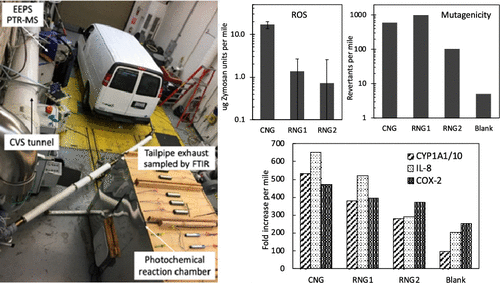当前位置:
X-MOL 学术
›
Environ. Sci. Technol.
›
论文详情
Our official English website, www.x-mol.net, welcomes your
feedback! (Note: you will need to create a separate account there.)
Chemical and Toxicological Properties of Emissions from a Light-Duty Compressed Natural Gas Vehicle Fueled with Renewable Natural Gas
Environmental Science & Technology ( IF 10.8 ) Pub Date : 2021-02-08 , DOI: 10.1021/acs.est.0c04962 Yin Li 1 , Jian Xue 1 , Joshua Peppers 2 , Norman Y Kado 3 , Christoph F A Vogel 3 , Christopher P Alaimo 1 , Peter G Green 1 , Ruihong Zhang 2 , Bryan M Jenkins 2 , Minji Kim 1 , Thomas M Young 1 , Michael J Kleeman 1
Environmental Science & Technology ( IF 10.8 ) Pub Date : 2021-02-08 , DOI: 10.1021/acs.est.0c04962 Yin Li 1 , Jian Xue 1 , Joshua Peppers 2 , Norman Y Kado 3 , Christoph F A Vogel 3 , Christopher P Alaimo 1 , Peter G Green 1 , Ruihong Zhang 2 , Bryan M Jenkins 2 , Minji Kim 1 , Thomas M Young 1 , Michael J Kleeman 1
Affiliation

|
Biogas consisting primarily of methane (CH4) and carbon dioxide (CO2) can be upgraded to a transportation fuel referred to as renewable natural gas (RNG) by removing CO2 and other impurities. RNG has energy content comparable to fossil compressed natural gas (CNG) but with lower life-cycle greenhouse gas (GHG) emissions. In this study, a light-duty cargo van was tested with CNG and two RNG blends on a chassis dynamometer in order to compare the toxicity of the resulting exhaust. Tests for reactive oxygen species (ROS), biomarker expressions (CYP1A1, IL8, COX-2), and mutagenicity (Ames) show that RNG exhaust has toxicity that is comparable or lower than CNG exhaust. Statistical analysis reveals associations between toxicity and tailpipe emissions of benzene, dibenzofuran, and dihydroperoxide dimethyl hexane (the last identification is considered tentative/uncertain). Further gas-phase toxicity may be associated with tailpipe emissions of formaldehyde, dimethyl sulfide, propene, and methyl ketene. CNG exhaust contained higher concentrations of these potentially toxic chemical constituents than RNG exhaust in all of the current tests. Photochemical aging of the vehicle exhaust did not alter these trends. These preliminary results suggest that RNG adoption may be a useful strategy to reduce the carbon intensity of transportation fuels without increasing the toxicity of the vehicle exhaust.
中文翻译:

以可再生天然气为燃料的轻型压缩天然气汽车排放物的化学和毒理学性质
通过去除CO 2可以将主要由甲烷(CH 4)和二氧化碳(CO 2)组成的沼气升级为运输燃料,称为可再生天然气(RNG)。和其他杂质。RNG的能源含量可与化石压缩天然气(CNG)相提并论,但其生命周期温室气体(GHG)排放量较低。在这项研究中,在底盘测功机上使用CNG和两种RNG混合物对轻型货车进行了测试,以比较产生的尾气的毒性。对活性氧(ROS),生物标志物表达(CYP1A1,IL8,COX-2)和致突变性(Ames)的测试表明,RNG废气的毒性与CNG废气相当或更低。统计分析表明,毒性与苯,二苯并呋喃和二氢过氧化物二甲基己烷的尾气排放之间存在关联(最后一个标识被认为是暂定的/不确定的)。进一步的气相毒性可能与甲醛,二甲基硫醚,丙烯和甲基乙烯酮的尾气排放有关。在所有当前的测试中,CNG废气中这些潜在有毒化学成分的浓度均高于RNG废气。机动车尾气的光化学老化并没有改变这些趋势。这些初步结果表明,采用RNG可能是降低运输燃料碳强度而不增加汽车尾气毒性的有用策略。
更新日期:2021-03-02
中文翻译:

以可再生天然气为燃料的轻型压缩天然气汽车排放物的化学和毒理学性质
通过去除CO 2可以将主要由甲烷(CH 4)和二氧化碳(CO 2)组成的沼气升级为运输燃料,称为可再生天然气(RNG)。和其他杂质。RNG的能源含量可与化石压缩天然气(CNG)相提并论,但其生命周期温室气体(GHG)排放量较低。在这项研究中,在底盘测功机上使用CNG和两种RNG混合物对轻型货车进行了测试,以比较产生的尾气的毒性。对活性氧(ROS),生物标志物表达(CYP1A1,IL8,COX-2)和致突变性(Ames)的测试表明,RNG废气的毒性与CNG废气相当或更低。统计分析表明,毒性与苯,二苯并呋喃和二氢过氧化物二甲基己烷的尾气排放之间存在关联(最后一个标识被认为是暂定的/不确定的)。进一步的气相毒性可能与甲醛,二甲基硫醚,丙烯和甲基乙烯酮的尾气排放有关。在所有当前的测试中,CNG废气中这些潜在有毒化学成分的浓度均高于RNG废气。机动车尾气的光化学老化并没有改变这些趋势。这些初步结果表明,采用RNG可能是降低运输燃料碳强度而不增加汽车尾气毒性的有用策略。











































 京公网安备 11010802027423号
京公网安备 11010802027423号